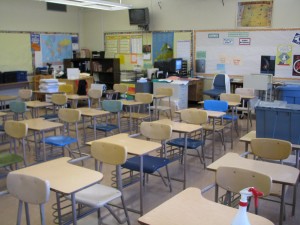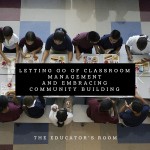 Every summer teachers rethink their classrooms. I am no exception. It just can’t happen during the school year beyond rearranging desks. I have a couple of friends who are urban planners and I pretend to be them, thinking about my space as if it were a small city. After all, classroom arrangement includes more than desks and bookshelves. It incorporates all the places that you and your students move, sit or work in the room. This includes storage.
Every summer teachers rethink their classrooms. I am no exception. It just can’t happen during the school year beyond rearranging desks. I have a couple of friends who are urban planners and I pretend to be them, thinking about my space as if it were a small city. After all, classroom arrangement includes more than desks and bookshelves. It incorporates all the places that you and your students move, sit or work in the room. This includes storage.
I was fortunate to have a huge room built in the 1920s. There was room for 42 bolted down desks (I know because the screw holes were still visible.) I had a huge wall of glass fronted cabinet, 2 small bulletin boards, a wall of nine foot tall windows and a long white board across the front of the room. I also had three electrical outlets in the entire room. While there was lots of room, everything had to be thought around those outlets. .
Every room has similar pluses and minuses. Write them down. This is the beginning of your plan.
Next, think what worked like a charm last year. It might have been where the word wall was placed, how the coat closet routine worked, or the system you came up with for storing daily writing notebooks. Make a list of them and determine why they worked so well. Personally, I’ve always been intrigued by the time motion studies. Efficiency is a wonder in a busy classroom. I don’t do fussy. The more streamlined and accessible, letting the kids to manage getting materials on their own, matter to me. Classroom arrangements that worked well in my room usually did this.
After deciding what worked fantastically in your room last year. Here’s your chance to put on your urban planner hat.
1. Where did the accidents occur? Not just falls, but spills, crashes and squabbles. What was in the area? Was it too crowded for the traffic flow? Was it poorly visible from your vantage point? Decide if it is a material or furniture placement or if it is a management issue.
For example, my coat closet became a dead-man’s crossing at the end of the day. I couldn’t move the coat closet although I made sure the access to it was as furniture-free as possible. Instead, I tackled it through management. I made sure none of my chatterers were seated near the access. I only let a few people at a time get their coats and bookbags. I also had everyone go to their seats and stay there until everyone was ready to line up. These small changes added up to a much calmer end of the day.
2. Where is your room overcrowded? Where were the traffic jams? Where did students crowd together? Did they move in more than one direction? I was a big fan of my round table that everyone flowed around to pick up materials, once I taught them to go the same direction. Placing tables so they can be walked around is ideal. If that is not possible try not to put it in the corner and leave space at the end so there is room for a child to move away from it without crashing into the person behind you. Put materials in a logical order. Think of it like a McDonald’s burger line. Everyone gets what they need without a mishap and the work begins more quickly.
3. What spaces are underutilized? What corner or cubby turned into a dumping ground?
Think about how you can change the use of that space. Maybe you can stick your storage bins there or maybe you can turn that space into the class library.
For a lot of teachers the underutilized space is their desk. Many of us never sit there. Some teachers chose to get rid of the desk. I did use mine but not the way you’d expect. Under my desk was the quiet place where a distraught child could go sit and calm down. The sides had little posters of gardens and there was a box of things to settle a troubled soul: a little pig stuffed with lavender, a bird puppet, a troll doll, and an indestructable stress tool (never a ball, those always were tossed into a crowd.) The top of my desk was covered with junk so I cleared it off and it became the supply center. The top had writing and scrap paper bins, a roll of paper towel, an open box of tissues, the scissors, and other day-to-day supplies.
4. Where in your room can’t you get to from here? What can you do to make things closer together? Do you need to put items in more than one place to alleviate the problem? My schools system’s custodial service decided that there could only be one trash can per classroom and it needed to be put next to the door. This meant every time someone blew their nose, they had to walk through the entire class to the garbage can. It was disruptive and made me nuts. I bought my room another can for the back of the room, and emptied it myself into the one in the front of the room. Since I had a good rapport with my custodian, she gave me trash bags and began emptying it herself when she swept the room at the end of the day.
5. Where were your kids always distracted? Was it the windows, the classroom door, or someplace where interesting things were stored? My kids wanted to look out the windows at the end of the day to see if their parents had arrived to pick them up. I moved low bookcases under all my windows to make it hard to go hang out near them. I moved my classroom rug from the front of the room to the back because the action in the hall distracted the wigglers.
6. How accessible are your materials? Accessibility means more than making accommodations for children with special needs. It means that you can get to what you need, when you need it. Who cares if you have to stand on your toes to reach your teacher guide once a day if the class can reach the materials they use. The stuff only I touched were hung higher on the wall than what my class touched. It saved me time that they cold reach the extra paper towels or tablets of paper. They could refill it while I was working with another child. It gave them a sense of self reliance to solve their own needs.
A famous urban planner, Jane Jacobs, said to keep your eyes on the street. This is true in a classroom as well as city. Look at what is going on where. Busy is fine, in fact, in a classroom it is what we want, but efficient is ideal. This way less time is spent cleaning up messes, or feelings, and we can get on with our real jobs: teaching.






Leave a comment